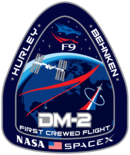Crew Dragon Demo-2
| Operator | |
|---|---|
| COSPAR ID | 2020-033A |
| SATCAT no. | 45623 |
| Spacecraft properties | |
| Spacecraft type | Crew Dragon C206 |
| Manufacturer | SpaceX |
| Crew | |
| Crew size | 2 |
| Members | Douglas G. Hurley Robert L. Behnken |
| Start of mission | |
| Launch date | April 2020[1] |
| Rocket | Falcon 9 Block 5 |
| Launch site | Kennedy Space Center, LC-39A |
| Orbital parameters | |
| Reference system | Geocentric |
| Regime | Low Earth |
| Inclination | 51.6° |
| Docking with ISS | |
| Time docked | 8 days |

 | |
Crew Dragon Demo-2, officially known as SpaceX Demo-2 and Crew Demo-2, will be the first crewed test flight of SpaceX's Crew Dragon spacecraft.[2]
Crew
| Position | Astronaut | |
|---|---|---|
| Commander | Third spaceflight | |
| Pilot | Third spaceflight | |
| Bob Behnken and Douglas Hurley were announced as the crew on 3 August 2018.[3] | ||
| Position[4] | Astronaut | |
|---|---|---|
| Commander | Second spaceflight | |
| Pilot | First spaceflight | |
Mission
The Demo-2 mission was originally planned for launch in July 2019 as part of the Commercial Crew Development contract[5] with a crew of two on a 14-day test mission to the International Space Station (ISS).[3] It is expected to be the first American spacecraft to fly crew into orbit since STS-135 in July 2011.[6] It would also be the first two-person American orbital spaceflight since STS-4 in June 1982. Depending on the success of their respective test programs, this honor should go to the SpaceX Crew Dragon.[7][8]
On April 20, 2019, the Crew Dragon capsule from the Demo-1 mission was destroyed during static fire testing of its SuperDraco thrusters, ahead of its planned use for an in-flight abort test.[9][10] SpaceX traced the cause of the static fire anomaly to a valve that leaked propellant into high pressure helium lines.
On 19 January 2020, a Crew Dragon capsule successfully completed an in-flight abort test.[11] The Demo-2 mission could now launch as early as April 2020.[12] NASA is considering extending the duration of the mission, enabling it to perform a standard crew rotation.[6]
Insignia
The mission insignia was designed by Andrew Nyberg, an artist from Brainerd, Minnesota. Nyberg is a nephew of Hurley.[13]
See also
- Boe-CFT, Boeing's first crewed mission of their capsule
References
- ^ https://spaceflightnow.com/2020/01/17/falcon-9-crew-dragon-in-flight-abort-test-mission-status-center/
- ^ "Upcoming Missions". spacexnow.com.
- ^ a b Lewis, Marie (3 August 2018). "Meet the Astronauts Flying SpaceX's Demo-2". Retrieved 3 August 2018.
- ^ https://twitter.com/Commercial_Crew/status/1116404828656291840
- ^ "NASA's Commercial Crew Program Target Test Flight Dates". February 6, 2019. Retrieved February 6, 2019.
- ^ a b Baylor, Michael (October 23, 2019). "SpaceX's Crew Dragon set for important test campaign". NASASpaceFlight.com.
- ^ https://spaceflightnow.com/launch-schedule/
- ^ https://blogs.nasa.gov/commercialcrew/
- ^ Baylor, Michael (April 20, 2019). "SpaceX's Crew Dragon spacecraft suffers an anomaly during static fire testing at Cape Canaveral – NASASpaceFlight.com". NASASpaceFlight.com.
{{cite news}}: Cite has empty unknown parameter:|1=(help) - ^ Berger, Eric (May 2, 2019). "Dragon was destroyed just before the firing of its SuperDraco thrusters". Ars Technica.
- ^ https://spaceflightnow.com/2020/01/17/falcon-9-crew-dragon-in-flight-abort-test-mission-status-center/
- ^ https://spaceflightnow.com/2020/01/17/falcon-9-crew-dragon-in-flight-abort-test-mission-status-center/
- ^ Murray, Robb. "Mankato native designed patch for upcoming NASA mission to the International Space Station". Mankato Free Press. Retrieved 14 November 2019.




